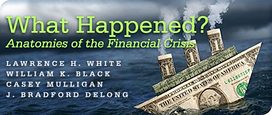William K. Black’s interesting contributions to this symposium, and in particular his drawing parallels to the S&L fiasco of the 1980s, prompt me to wonder what role financial safety nets, like the deposit insurance that fostered the S&L fiasco, have played in fostering the current crisis.
Professor Black focuses on the growth of deceptive (or fraudulent) accounting and ratings practices. Supervisors asleep at the switch enabled both. But why did the practices begin to grow? Their main purpose, according to a very informative working paper, “The 2007 Meltdown in Structured Securitization: Searching for Lessons not Scapegoats” by Gerard Caprio, Jr., Aslı Demirgüç-Kunt, and Edward J. Kane (CDK), was to mask overleveraging and excessive risk exposures from creditors and safety-net supervisors. (Note that Ed Kane was the analyst who warned about the developing S&L crisis years before it hit the newspapers.)
If they are right, then a key question becomes: what prompted the overleveraging and excess risk-taking in the first place? CDK argue that an important contributor was “safety-net subsidies,” i.e., moral hazard from implicit or explicit financial guarantees.
CDK write:
During the last forty years financial institutions in the US … became increasingly aware of opportunities to shift the deep downside of their risk exposures onto the safety net. … [In recent years] financial institutions increasingly concentrated on creating instruments and structures with which to exploit loopholes in the regulation and supervision of financial-institution leverage. (p. 6) … Securitization increased these firms’ access to safety-net subsidies not just by increasing their size, complexity or geographic footprint, but also and most importantly by concealing increases in effective leverage. (pp. 6-7)
In tolerating an ongoing decline in transparency, supervisors encouraged the very mispricing of risk whose long-overdue correction triggered the crisis. (p. 9)
Why were the deceptive practices especially keen in mortgage financing? And why were the supervisors asleep at the switch? The Federal Reserve’s cheap-money policy and its positive impact on housing prices contributed. Everything looked fine as long as house prices continued to rise: “Low interest rates and increasing housing prices encouraged an overly friendly regulatory environment both for highly leveraged mortgages and for securitization structures based on them.” (p. 12)
Like the FSLIC that practiced excessive forbearance toward zombie thrifts, hoping for the best, it is clear in retrospect that the FDIC practiced excessive deference toward the AAA risk ratings of mortgage-backed securities. It should have raised deposit insurance premiums or insisted on higher capital requirements for insured institutions heavily invested in MBSs. Likewise the OFHEO practiced forbearance toward Fannie Mae and Freddie Mac when it should have insisted on adequate capitalization for their risky portfolios.
I wonder whether Professor Black finds the CDK analysis complementary or contrary to his own.

